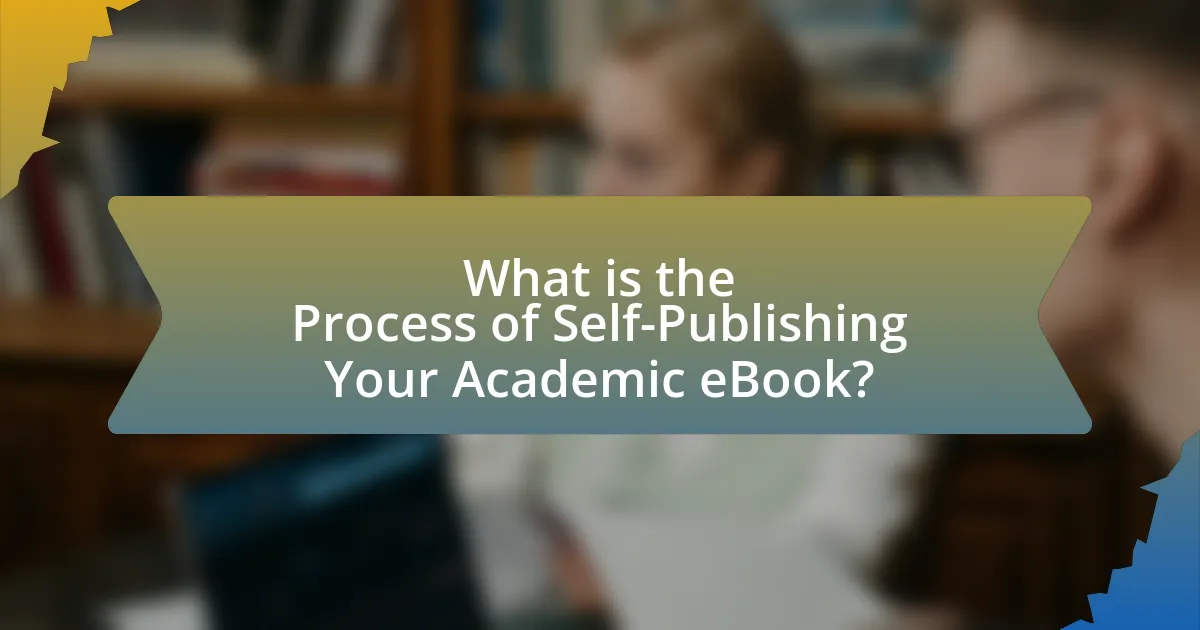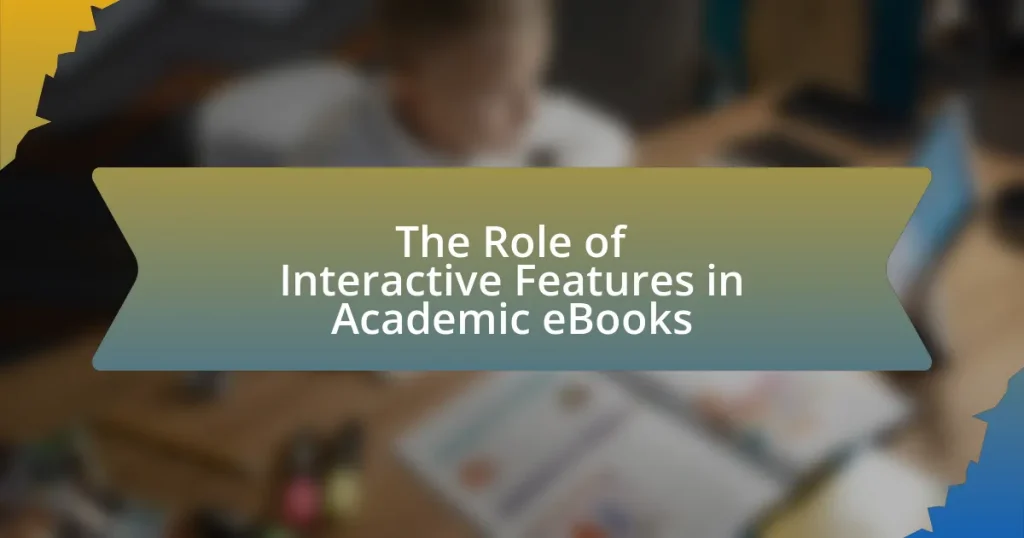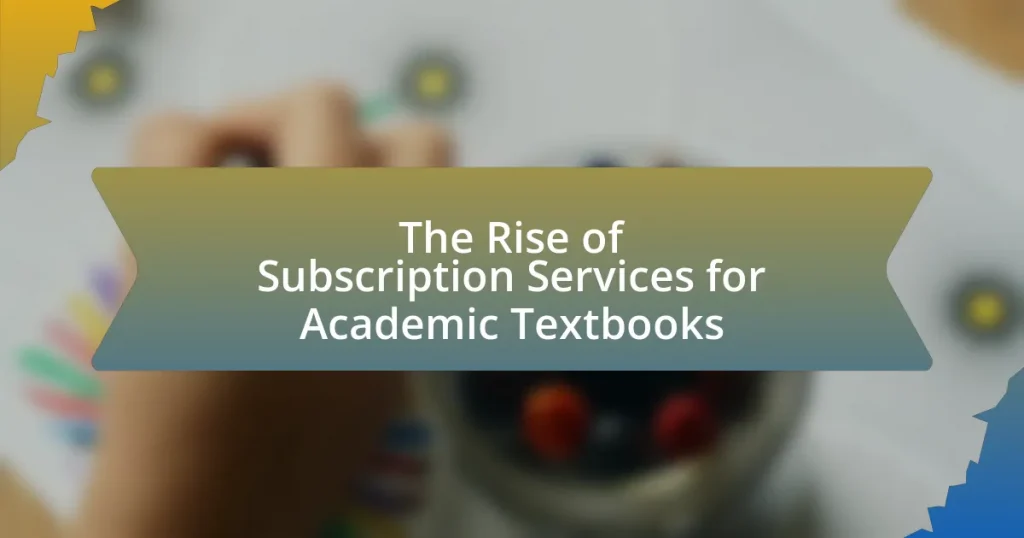The article focuses on the process of self-publishing academic eBooks, detailing essential steps such as writing, editing, formatting, selecting a publishing platform, and marketing. It contrasts self-publishing with traditional publishing, highlighting the control and financial benefits for authors. Key advantages of self-publishing include faster publication timelines and higher royalty rates, while challenges encompass marketing and quality control. The article also outlines best practices for manuscript preparation, pricing strategies, and effective marketing techniques, providing a comprehensive guide for academics looking to self-publish their work.

What is the Process of Self-Publishing Your Academic eBook?
The process of self-publishing your academic eBook involves several key steps: writing, editing, formatting, choosing a publishing platform, and marketing. First, the author must complete the manuscript, ensuring it meets academic standards. Next, professional editing is crucial to enhance clarity and coherence. After editing, formatting the eBook according to the chosen platform’s specifications is necessary, which may include converting the document into formats like EPUB or MOBI.
Once formatted, the author selects a self-publishing platform, such as Amazon Kindle Direct Publishing or IngramSpark, to distribute the eBook. Finally, effective marketing strategies, including social media promotion and academic networking, are essential to reach the target audience. This structured approach ensures that the academic eBook is professionally presented and accessible to readers.
How does self-publishing differ from traditional publishing?
Self-publishing differs from traditional publishing primarily in the control and responsibility an author has over the publishing process. In self-publishing, authors retain full rights to their work, manage the entire publishing process, and are responsible for marketing, distribution, and sales. In contrast, traditional publishing involves a publishing house that takes on these responsibilities, often requiring authors to relinquish some rights and control in exchange for professional support and resources. According to a 2021 report by the Author Earnings Project, self-published authors can earn up to 70% of their royalties, while traditionally published authors typically receive around 10-15%. This financial difference highlights the significant impact of the publishing model on an author’s earnings and creative autonomy.
What are the key advantages of self-publishing for academics?
Self-publishing offers academics significant advantages, including greater control over content, faster publication timelines, and higher royalty rates. Academics can tailor their work to specific audiences without the constraints of traditional publishing, allowing for more personalized and relevant content. Additionally, self-publishing typically enables authors to publish their work more quickly, bypassing lengthy review processes associated with traditional publishers. Furthermore, academics retain a larger share of profits, often receiving royalties that can exceed 70%, compared to the 10-15% common in traditional publishing. These factors collectively enhance the academic’s ability to disseminate knowledge effectively and efficiently.
What challenges do authors face when self-publishing?
Authors face several challenges when self-publishing, including marketing, distribution, and quality control. Marketing is particularly difficult as authors must compete with established publishers and navigate the complexities of online promotion without the support of a marketing team. Distribution poses another challenge, as authors need to choose the right platforms to reach their target audience effectively, which can be overwhelming given the multitude of options available. Quality control is also a significant concern; authors must ensure their work is professionally edited and formatted, which often requires hiring external services, adding to the overall cost. According to a survey by the Alliance of Independent Authors, 70% of self-published authors report that marketing is their biggest hurdle, highlighting the importance of strategic planning in the self-publishing process.
What steps are involved in the self-publishing process?
The self-publishing process involves several key steps: writing, editing, formatting, designing a cover, choosing a publishing platform, uploading the manuscript, setting a price, and marketing the book.
Initially, the author writes the manuscript, followed by a thorough editing phase to ensure clarity and coherence. Formatting the manuscript for eBook compatibility is crucial, as it affects readability on various devices. The cover design is also important, as it serves as the first impression for potential readers.
Next, the author selects a self-publishing platform, such as Amazon Kindle Direct Publishing or IngramSpark, to distribute the eBook. After uploading the manuscript and cover, the author sets a price based on market research and personal goals. Finally, effective marketing strategies, including social media promotion and email campaigns, are implemented to reach the target audience.
These steps are essential for successfully self-publishing an academic eBook, as they ensure the work is polished, accessible, and marketed effectively.
How do you prepare your manuscript for self-publishing?
To prepare your manuscript for self-publishing, you should first ensure that it is thoroughly edited and formatted according to industry standards. This involves multiple rounds of editing, including developmental editing for content structure, copyediting for grammar and style, and proofreading for final errors. Additionally, formatting should adhere to the specifications of the self-publishing platform you choose, such as Kindle Direct Publishing or IngramSpark, which often require specific file types and layout guidelines.
Proof of the importance of these steps can be seen in the fact that professionally edited and well-formatted manuscripts significantly increase the chances of positive reviews and sales, as evidenced by a survey conducted by the Editorial Freelancers Association, which found that 70% of readers are more likely to recommend a book that is well-edited.
What formatting requirements must be met for an academic eBook?
An academic eBook must meet specific formatting requirements to ensure readability and accessibility. These requirements typically include using a standard file format such as EPUB or PDF, maintaining a consistent layout with clear headings and subheadings, and incorporating a table of contents for easy navigation. Additionally, the text should be formatted with appropriate font sizes and styles, and images must be high-resolution and properly attributed. These standards are essential for compatibility with various e-readers and devices, enhancing the user experience and ensuring that the content is presented professionally.
What platforms are available for self-publishing academic eBooks?
Several platforms are available for self-publishing academic eBooks, including Amazon Kindle Direct Publishing, Smashwords, Lulu, and IngramSpark. Amazon Kindle Direct Publishing allows authors to publish eBooks and reach a vast audience through Amazon’s marketplace. Smashwords offers a distribution network that includes major retailers and libraries, making it suitable for academic authors. Lulu provides tools for creating and distributing eBooks, along with print options, catering to a variety of academic needs. IngramSpark is known for its extensive distribution capabilities, allowing authors to reach bookstores and libraries globally. Each of these platforms offers unique features that can support the self-publishing process for academic eBooks.
Which platforms are most popular among academic authors?
The most popular platforms among academic authors for self-publishing their eBooks include Amazon Kindle Direct Publishing (KDP), IngramSpark, and Smashwords. Amazon KDP dominates the market, accounting for a significant share of eBook sales, making it a preferred choice due to its vast reach and user-friendly interface. IngramSpark is favored for its extensive distribution network, allowing authors to reach libraries and bookstores globally. Smashwords is known for its flexibility and wide distribution options, catering to authors looking for broader exposure. These platforms are widely recognized for their effectiveness in helping academic authors publish and distribute their work efficiently.
How do you choose the right platform for your eBook?
To choose the right platform for your eBook, evaluate factors such as distribution reach, royalty rates, and formatting options. Platforms like Amazon Kindle Direct Publishing offer extensive reach and competitive royalties, while others like Smashwords provide broader distribution to multiple retailers. Additionally, consider the ease of use and support for various file formats, as platforms that support EPUB or PDF may better suit your needs. Researching user reviews and comparing features can further guide your decision, ensuring that the platform aligns with your specific goals for self-publishing your academic eBook.
How can you effectively market your self-published academic eBook?
To effectively market your self-published academic eBook, utilize a multi-channel approach that includes social media promotion, academic networking, and targeted advertising. Social media platforms like Twitter and LinkedIn allow you to engage with academic communities and share insights related to your eBook’s content, increasing visibility. Academic networking sites such as ResearchGate and Academia.edu enable you to connect with peers and share your work directly with interested audiences. Additionally, targeted advertising on platforms like Facebook and Google can help reach specific demographics interested in your subject matter. According to a study by the Pew Research Center, 72% of adults use social media, making it a vital tool for reaching potential readers.
What strategies can be used to reach your target audience?
To reach your target audience effectively, utilize strategies such as social media marketing, email campaigns, and content marketing. Social media platforms like Twitter and LinkedIn allow for targeted advertising, enabling you to reach specific demographics interested in academic topics. Email campaigns can be personalized to engage potential readers directly, increasing the likelihood of conversion. Content marketing, including blog posts and webinars, positions you as an authority in your field, attracting your audience through valuable information. According to a HubSpot report, companies that prioritize blogging are 13 times more likely to achieve a positive ROI, demonstrating the effectiveness of these strategies in engaging target audiences.
How important is social media in promoting your eBook?
Social media is crucial in promoting your eBook, as it provides a platform for reaching a wide audience quickly and effectively. Research indicates that 73% of marketers believe that their efforts through social media marketing have been “somewhat effective” or “very effective” for their business, highlighting its significance in digital promotion. Additionally, platforms like Facebook, Twitter, and Instagram allow authors to engage directly with potential readers, share content, and build a community around their work, which can lead to increased visibility and sales.
What are the common pitfalls to avoid in self-publishing?
Common pitfalls to avoid in self-publishing include inadequate editing, poor cover design, and neglecting marketing strategies. Inadequate editing can lead to a subpar reading experience, as studies show that professionally edited books have higher sales and better reviews. Poor cover design can deter potential readers; research indicates that 75% of consumers judge a book by its cover. Neglecting marketing strategies results in limited visibility; according to a survey by the Alliance of Independent Authors, 70% of self-published authors report that effective marketing is crucial for success.
How can you ensure quality in your self-published work?
To ensure quality in your self-published work, implement a thorough editing and review process. This involves hiring professional editors to refine the manuscript, as studies show that professionally edited books have higher reader satisfaction and lower error rates. Additionally, gather feedback from beta readers who represent your target audience, as their insights can highlight areas for improvement. Incorporating these practices not only enhances the content but also increases the credibility and marketability of your academic eBook.
What legal considerations should you be aware of?
When self-publishing an academic eBook, you should be aware of copyright laws, licensing agreements, and plagiarism issues. Copyright laws protect the original work, meaning you must ensure that your content is either your own or properly licensed. Licensing agreements dictate how others can use your work, and understanding these terms is crucial to avoid legal disputes. Additionally, plagiarism can lead to serious academic and legal repercussions, so it is essential to properly attribute sources and ensure originality in your writing. These legal considerations are vital for protecting your intellectual property and maintaining academic integrity.
What are the best practices for pricing your academic eBook?
The best practices for pricing your academic eBook include conducting market research, understanding your target audience, and considering production costs. Market research helps identify competitive pricing by analyzing similar academic eBooks in your field, which typically range from $9.99 to $49.99 depending on content depth and audience. Understanding your target audience allows you to set a price that reflects their willingness to pay; for instance, students may prefer lower prices, while institutions may be willing to pay more for comprehensive resources. Additionally, factoring in production costs, including editing, design, and distribution, ensures that your pricing covers expenses while remaining attractive to buyers. These practices are supported by industry reports indicating that well-researched pricing strategies can increase sales and enhance perceived value.
How do you determine the right price point for your eBook?
To determine the right price point for your eBook, analyze market trends, competitor pricing, and the perceived value of your content. Research shows that eBooks in similar genres typically range from $2.99 to $9.99, with pricing strategies often influenced by factors such as length, depth of research, and target audience. For instance, a study by the Author Earnings Report indicates that eBooks priced between $3.99 and $5.99 tend to achieve higher sales volumes, suggesting that this range may optimize both visibility and revenue. Additionally, consider conducting surveys or gathering feedback from potential readers to assess their willingness to pay, which can further refine your pricing strategy.
What pricing strategies can maximize your sales?
Dynamic pricing strategies can maximize your sales by adjusting prices based on demand, competition, and customer behavior. Implementing techniques such as price skimming, where initial high prices are set and gradually lowered, can attract early adopters and maximize revenue. Additionally, employing psychological pricing, such as setting prices just below a round number, can influence consumer perception and increase sales. Research indicates that businesses using dynamic pricing can see revenue increases of up to 25% compared to static pricing models.
What resources are available for self-publishing authors?
Self-publishing authors have access to various resources, including platforms, tools, and communities that facilitate the publishing process. Key platforms such as Amazon Kindle Direct Publishing, IngramSpark, and Smashwords provide authors with the means to publish and distribute their eBooks globally. Additionally, tools like Canva and Scrivener assist in design and writing, respectively. Communities such as the Alliance of Independent Authors and various online forums offer support and guidance. According to a 2021 survey by the Independent Book Publishers Association, 30% of authors reported using self-publishing services, highlighting the growing reliance on these resources for successful self-publishing.
Where can you find support and guidance during the process?
You can find support and guidance during the process of self-publishing your academic eBook through various resources such as online forums, academic writing groups, and self-publishing platforms. Online forums like Reddit’s r/selfpublish and specialized groups on Facebook provide community support and shared experiences. Academic writing groups often offer peer feedback and advice on content and formatting. Additionally, self-publishing platforms like Amazon Kindle Direct Publishing and IngramSpark provide comprehensive guides and customer support to assist authors throughout the publishing process. These resources collectively enhance the self-publishing experience by offering practical advice and community engagement.
What tools can assist in the self-publishing journey?
Various tools can assist in the self-publishing journey, including writing software, formatting tools, and distribution platforms. Writing software like Scrivener helps authors organize their content effectively, while formatting tools such as Reedsy and Vellum ensure that the manuscript meets industry standards for eBooks. Additionally, distribution platforms like Amazon Kindle Direct Publishing and IngramSpark facilitate the publishing process by providing access to a wide audience and managing sales. These tools streamline the self-publishing process, making it more efficient and accessible for authors.
What tips can help ensure a successful self-publishing experience?
To ensure a successful self-publishing experience, authors should focus on thorough editing, professional cover design, and effective marketing strategies. Thorough editing enhances the quality of the manuscript, as studies show that professionally edited books receive higher ratings and sales. A professional cover design attracts readers; research indicates that 75% of consumers judge a book by its cover. Finally, implementing effective marketing strategies, such as utilizing social media and email newsletters, can significantly increase visibility and sales, as evidenced by the success of self-published authors who actively engage with their audience.















